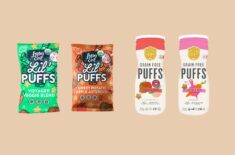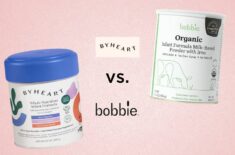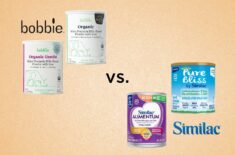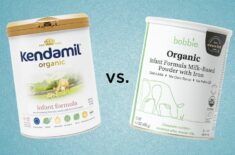Overview
Rice and oat cereals are often the first foods introduced into a baby’s diet because they’re less likely to cause allergies than other grains, particularly wheat. (1)
So, when can you start giving complementary foods to your baby, and which one should you choose: rice or oatmeal cereal?
The AAP (American Academy of Pediatrics) recommends introducing solid foods when your baby is four or six months of age, but only when they’re ready. Infant cereals and jarred baby foods can be good options for your child. (2)(3)
What Is The Best Baby Cereal To Start With?
Many different brands and flavors of packaged rice and oatmeal cereals are readily available. Choosing which one to give your baby may depend on your personal preferences and your baby’s reaction to the new food.
Oats have a nutty taste that your child might love. But brown, black, and basmati rice can also have a nutty flavor. (4)
Oats can prevent gastrointestinal problems and may have anticancer effects. (5)
While oats may have a higher nutritional value, it’s among the 14 most common allergens. But rice rarely causes allergic reactions. (6)(7)
But there are also growing concerns about rice and rice-based products having high levels of arsenic.
The FDA’s 2016 risk assessment report shows that rice and rice products rank second among foods with the highest arsenic content. (8)
High levels of toxic metals in baby foods are alarming, especially because they can harm your baby’s brain development. They may lead to behavioral, learning, and cognitive problems. (9)
Though they aren’t arsenic-free, oats tend to have lower toxic metal levels than rice. (10)
But which one should you choose: rice or oatmeal cereal? No matter which one you choose, the AAP recommends iron-fortified cereals formulated for babies. (11)
You can find more information below to help you pick the right cereal for your little one.
Oatmeal Vs Rice Cereal
Rice Cereal Pros & Cons
What Makes Rice Cereal Better
- Although rice allergy is possible, it’s rare. This grain is widely recognized as a relatively low allergenic food. (12)
- There are many varieties of rice, but the most common is white rice. Many rice cereal products are made using this type. (4)
- Though white rice can be tasteless, you can pick a cereal made from brown, black, or basmati rice if your kid prefers a nutty flavor. (4)
Why Rice Cereal Is Not Recommended?
- White rice can be tasteless. (4)
- Rice and rice-based products may have high levels of arsenic. (8)
- According to the FDA’s 2016 risk assessment report, rice and rice products have the second-highest arsenic content among all foods. (8)
- This high arsenic content may harm your baby’s brain development and lead to learning, behavioral, and cognitive problems. (9)
- The 2017 HBBF (Healthy Babies Bright Futures) study shows that infant rice cereal may contain more than 84% inorganic arsenic than non-rice and multigrain varieties. (13)
The maximum level for inorganic arsenic in infant rice cereal is 100 ppb. (14)
Non-profit organization Consumer Reports conducted tests on rice and rice-based products in 2012. They discovered that many infant cereal products have alarming levels of arsenic. (10)
For example, a sample of Gerber SmartNourish Organic Brown Rice cereal had as high as 329 ppb. Other brands also have high levels of this toxic heavy metal. (10)
Consumer Reports also noted that plenty of babies in the US typically eat two to three servings of rice cereals a day. (10)
Division of the National Toxicology Program laboratory chief Michael Waalkes warns: (10)
“This is a time when cells are differentiating into organs and many other important developmental things are going on, so getting exposed to a toxicant like arsenic in utero or during early childhood can cause damage that may not appear until decades later.”
Still, the report noted that rice isn’t the only food with arsenic. Seafood and many fruit juices, such as apples and grapes, also contain high arsenic levels. But because of the higher consumption of rice cereals by infants, they can put more kids at risk than these other sources. (10)
To reduce arsenic consumption, Consumer Reports recommends that you limit rice cereal consumption to just one serving a day for your baby. They also prohibit giving rice drinks to children. (10)
Oatmeal Cereal Pros & Cons
What Makes Oatmeal Cereal Better
- Oats have a nutty taste that your kid might love.
- Oats can have a higher nutritional value than rice. (5)
- They’re rich in lipids (the body’s energy reserve), phytochemicals (immune system support), and vitamin E (antioxidants that may protect your baby’s body from harmful free radicals). (5)
- Oat consumption can provide your baby with more dietary fibers that can help alleviate or prevent constipation. (5)
- Oats may also have anticancer effects and can prevent gastrointestinal problems. (5)
- Whole-grain foods such as oats are low in saturated fat. They may help reduce cholesterol and your baby’s risk of heart disease. (15)
- They aren’t arsenic-free, but oats tend to have lower levels of this toxic metal than rice. (10)
- Tests conducted by Consumer Reports showed that some infant rice cereals might have at least five times the amount of inorganic arsenic than alternatives such as oatmeal. (10)
Cons
- It’s among the 14 most common allergens. (6)(7)
- Oats are gluten-free, but they contain avenin, a protein that can also trigger an allergic reaction in sensitive babies. But avenin allergy or oat allergy is less common than gluten allergy. (16)
- Oatmeal cereal can also become contaminated with gluten if produced in a facility that processes gluten-containing ingredients, too. (17)
Infant Cereals Pros & Cons
These are the advantages and disadvantages of giving iron-fortified infant cereals to your baby, no matter which infant cereal you pick between rice and oatmeal options.
Pros
- They’re a good source of iron. You can maximize this benefit by feeding your child foods rich in vitamin C, which can enhance iron absorption. These foods include kiwis, kale, broccoli, oranges, and strawberries. (18)
- They’re convenient and easy to prepare.
- There are lots of flavors and textures available.
- Your baby may accept cereals easily.
- These may be an ideal option when your baby is ready for weaning.
Cons
- Some babies might prefer infant cereals over veggies and purees. This might make it more difficult to provide them with other nutrient sources.
- If you exclusively feed your baby with infant cereals, transitioning to table foods may become more difficult.
- Although they’re gluten-free, it’s still possible for rice and oatmeal cereal to have gluten if they have gluten-containing ingredients or additives. So, check the label to ensure your child isn’t eating a product with gluten, especially if your child is allergic to this component. (17)
Best Baby Oatmeal Cereals
Oatmeal cereals may be a healthier choice, especially if you want baby food that doesn’t have high levels of arsenic.
These are some of the best options you can pick for your baby:
Holle Organic Oatmeal Porridge Rolled Oats Cereal 



- It’s made with whole-grain oat flour.
- It’s free from milk (a potential allergen) and added sugars.
- It’s free from GMOs (genetically modified organisms) which may cause allergic reactions, reduced immune function, toxicity, antibiotic resistance, and cancer. (20)
- The brand claims that this cereal is formulated in an easily digestible form.
- It’s certified organic by the strictest Demeter EU (European Union) standards.
- It’s free from hormones, antibiotics, steroids, eggs, and preservatives.
- It also has vitamin B1 (thiamin), an essential nutrient that can help your baby generate energy from nutrients. (19)
Cons: It isn’t fortified with iron. But it may still be safe for consumption, as long as your child can get enough iron from formula or supplements. Make sure to seek your pediatrician’s recommendation.
Quaker Oats Gluten-Free Old-Fashioned Oats 
- It’s made with 100% whole grain oats
- It’s free from gluten, added sugar, and sodium (salt).
- It’s fortified with iron (1.5 mg)
- It also contains calcium (20 mg).
- This product is Non-GMO Project verified.
Fleur Alpine Milk & Oatmeal Cereal – price not available
- It’s made from 100% whole grain.
- It has vitamin B1 (thiamin), which may help your baby generate energy from nutrients. (19)
- It’s free from added sugar or salt.
- It features a tender consistency that can make it easier to digest and absorb.
- It’s an organic product produced in Germany, following strict European regulations.
Cons: The product isn’t fortified with iron. But your child’s pediatrician can recommend iron supplements and formula with ample iron content.
This product also contains maltodextrin and milk (a potential allergen).
Bio Kinetics Oats Baby Cereal

- It’s made with organic sprouted oat flakes.
- It uses BPA-free packaging for your baby’s safety. BPA (bisphenol-A) is a toxic industrial chemical used in making plastics. (21)
- It’s fortified with iron (1.12 mg).
- It’s free from salt, trans-fats, and added sugars.
Best Baby Rice Cereals
The type of cereal you choose to give your baby depends on your preferences. But if you want to give one with rice grains, you can choose from these products:
Holle Organic Rice Cereal


- It’s made with whole-grain millet flour.
- It’s free from gluten, milk (an allergen), and added sugars.
- It’s free from GMOs (genetically modified organisms) which may cause reduced immune function, allergic reactions, toxicity, antibiotic resistance, and cancer. (20)
- The brand claims that it’s formulated in an easily digestible form.
- It’s certified organic by strict EU (European Union) standards.
- It’s free from steroids, hormones, antibiotics, eggs, and preservatives.
- It also contains vitamin B1 (thiamin); this essential nutrient can help your baby generate energy from nutrients. (19)
Cons: This product isn’t fortified with iron. But your child can still get enough iron from formula or supplements, with your pediatrician’s recommendation.
Fleur Alpine Hypoallergenic Rice Cereal

- It’s made from 100% whole grain.
- It’s gluten-free.
- It contains vitamin B1 (thiamin), which can help your baby generate energy from nutrients. (19)
- It’s free from added milk, sugar, or salt.
- It features a tender consistency that may make it easier to digest and absorb.
- It’s an organic product.
- It’s produced in Germany, following strict European regulations.
Cons: The product isn’t fortified with iron. But your child may still get enough iron from their formula, or a pediatrician can recommend iron supplements.
Bio Kinetics Brown Rice, Lentils & Carrot
- It’s made from organic sprouted brown rice, organic carrots, and organic sprouted lentils.
- It’s free from any preservatives, GMOs, or artificial vitamins and minerals.
- It’s fortified with iron (2 mg).
- It also contains calcium (11 mg).
Lebenswert Organic Rice Porridge

- It’s made from rice wholemeal flour.
- It may be easy to digest.
- It’s free from gluten, milk (a potential allergen), and added sugars.
- It doesn’t contain steroids, antibiotics, hormones, GMO ingredients, eggs, or preservatives.
- It’s Bioland certified, the highest quality certification for European organic products.
- It contains thiamin (vitamin B1) which can help your baby’s body generate energy from nutrients. (19)
Cons: It isn’t iron-fortified. Remember to consult with a pediatrician whether your baby will need supplements if you decide on using this product.
Organix Baby Rice Porridge

- This product is free from gluten.
- It doesn’t have artificial sweeteners, coloring, preservatives, or flavors.
- It’s made under strict EU (European Union) organic standards.
- It has vitamin B1 (thiamin), which can help in energy generation from nutrients. (19)
Cons: It may contain traces of nuts.
This product isn’t iron-fortified. Consult with your pediatrician whether your child needs supplements.
Summary And Recommendations
In choosing between oatmeal vs rice cereal, consider the following:
Choose Rice Cereal if:
- You prefer a cereal that has a lower possibility of causing an allergic reaction. (12)
Choose Oatmeal Cereal if:
- Your child prefers the nutty taste of oats.
- You prefer to give your child cereal with a higher nutritional value. (5)
- You want a cereal rich in phytochemicals (immune system support), lipids (the body’s energy reserve), and vitamin E (antioxidants that fight harmful free radicals). (5)
- You prefer cereal that may help prevent constipation and gastrointestinal problems. (5)
- You prefer cereal that may have anticancer effects and can reduce your baby’s risk of heart disease. (5)(15)
- You want a cereal that’s low in arsenic and other toxic heavy metals. (10)
Remember that your child’s safety should always come first. That’s why we recommend choosing oatmeal cereal over rice cereal unless your child is allergic to oats.
Toxic Metals In Popular Rice & Oatmeal Cereals
The FDA set these maximum limits (in ppb or parts per billion) for bottled water: (14)
- 5 ppb lead
- 5 ppb cadmium
- 10 ppb inorganic arsenic
While the maximum level for infant rice cereal is 100 ppb inorganic arsenic. (14)
The limit for mercury in drinking water (may also apply to food) is 2 ppb, based on EPA (Environmental Protection Agency) guidelines. (22)
But independent studies conducted by HBBF (Healthy Babies Bright Futures) and Consumer Reports show that many popular brands can have high levels of toxic chemicals. (10)(13)
According to the HBBF report, some popular brands of infant rice cereals may contain as high as 84% more inorganic arsenic than multigrain or non-rice varieties. Products made with oatmeal, corn, barley, and quinoa may have lower toxic metal content. (13)
Toxic Metals In Rice Cereals
The following are results from the HBBF study: (13)
Beech-Nut Rice Single Grain Baby Cereal (Stage 1)
- Total arsenic: 117 ppb
- Inorganic arsenic: 86 ppb
- Lead: 3.5 ppb
- Cadmium: 5.4 ppb
- Mercury: 0.582 ppb
BioKinetics Brown Rice Organic (Sprouted Whole Grain Baby Cereal)
- Total arsenic: 353 ppb
- Inorganic arsenic: 144 ppb
- Lead: 3.1 ppb
- Cadmium: 31.7 ppb
- Mercury: 2.32 ppb
Earth’s Best Whole Grain Rice Cereal (sample 1)
- Total arsenic: 138 ppb
- Inorganic arsenic: 113 ppb
- Lead: 22.5 ppb
- Cadmium: 14.7 ppb
- Mercury: 2.41 ppb
Earth’s Best Whole Grain Rice Cereal (sample 2)
- Total arsenic: 126 ppb
- Inorganic arsenic: 107 ppb
- Lead: 17.8 ppb
- Cadmium: 13.4 ppb
- Mercury: 2.19 ppb
Gerber Single-Grain Rice Baby Cereal
- Total arsenic: 106 ppb
- Inorganic arsenic: 74 ppb
- Lead: 3.9 ppb
- Cadmium: 11.1 ppb
- Mercury: 1.79 ppb
Healthy Times Organic Brown Rice Cereal (4+ months)
- Total arsenic: 153 ppb
- Inorganic arsenic: 133 ppb
- Lead: 67.4 ppb
- Cadmium: 12.1 ppb
- Mercury: 1.53 ppb
Kitchdee Organic Baby Cereal (Rice and Lentil)
- Total arsenic: 79.3 ppb
- Inorganic arsenic: 78 ppb
- Lead: 10.9 ppb
- Cadmium: 13.1 ppb
- Mercury: 4.06 ppb
Toxic Metals In Oatmeal Cereals
The following are results from the HBBF study: (13)
HappyBABY Oats & Quinoa Baby Cereal (Organic Whole Grains with Iron)
- Total arsenic: 10.2 ppb
- Inorganic arsenic: Not measurable
- Lead: 0.9 ppb
- Cadmium: 12.4 ppb
- Mercury: <0.14 ppb
Beech-Nut Oatmeal Whole Grain Baby Cereal (Stage 1)
- Total arsenic: 23.8 ppb
- Inorganic arsenic: Not measurable
- Lead: 2.2 ppb
- Cadmium: 13 ppb
- Mercury: <0.139 ppb
Earth’s Best Whole Grain Oatmeal Cereal
- Total arsenic: 29.5 ppb
- Inorganic arsenic: 27 ppb
- Lead: 2 ppb
- Cadmium: 20.1 ppb
- Mercury: <0.277 ppb
Gerber Oatmeal Single Grain Cereal
- Total arsenic: 26.9 ppb
- Inorganic arsenic: Not measurable
- Lead: 3 ppb
- Cadmium: 13 ppb
- Mercury: <0.281 ppb
Happy Baby Oatmeal Baby Cereal (Organic Whole Grains)
- Total arsenic: 6.3 ppb
- Inorganic arsenic: Not measurable
- Lead: <0.5 ppb
- Cadmium: 10 ppb
- Mercury: <0.14 ppb
Harvest Hill Instant Oatmeal, Maple & Brown Sugar
- Total arsenic: 13.5 ppb
- Inorganic arsenic: Not measurable
- Lead: 8.1 ppb
- Cadmium: 5.8 ppb
- Mercury: <0.14 ppb
The following are results from the tests commissioned by Consumer Reports: (10)
Beech-Nut Homestyle Rice Cereal
- Total arsenic: 130 ppb
- Inorganic arsenic: 67.1 ppb
- Lead: 3.8 ppb
- Cadmium: 8.7 ppb
- Mercury: Not tested
Earth’s Best Organic Whole Grain Rice Cereal
- Total arsenic: 274 ppb
- Inorganic arsenic: 180 ppb
- Lead: 1.1 ppb
- Cadmium: 15.6 ppb
- Mercury: Not tested
Gerber Rice Cereal
- Total arsenic: 264 ppb
- Inorganic arsenic: 109 ppb
- Lead: 5.6 ppb
- Cadmium: 24.6 ppb
- Mercury: Not tested
Gerber SmartNourish Organic Brown Rice Cereal
- Total arsenic: 329 ppb
- Inorganic arsenic: 86 ppb
- Lead: 11.9 ppb
- Cadmium: 14.6 ppb
- Mercury: Not tested
2021 Congressional Baby Food Safety Reports
In February and September 2021, the US Congress’ Subcommittee on Economic and Consumer Policy released baby food safety reports involving seven top brands in the US: (23)(24)
- Nurture, Inc. (Baby Food Recall and HappyTOT)
- Beech-Nut Nutrition Company (Beech-Nut)
- Hain Celestial Group, Inc. (Earth’s Best Organic)
- Gerber
- Campbell’s Plum Organics
- Walmart Inc. (Parent’s Choice)
- Sprout Foods, Inc. (Sprout Organic Foods)
These brands were called out for having alarmingly high levels of toxic heavy metals. But despite figuring in the Congressional report, none of the brands recalled their products.
In the follow-up report released in September 2021, the Subcommittee also published results from FDA-funded tests on multiple Gerber and Beech-Nut samples: (24)
- Beech-Nut rice cereal tested up to 125 ppb inorganic arsenic and 85.47 ppb inorganic arsenic.
- Gerber’s rice cereal may have up to 116 ppb inorganic arsenic and 87.43 ppb inorganic arsenic.
Beech-Nut recalled the batches/lots sampled by the FDA. (25)
But no other recalls were issued on other products, including the products that tested high levels of heavy metals in reports by the HBBF and Consumer Reports. (10)(13)(25)
In addition to the recall, Beech-Nut also decided to stop making rice cereal over concerns that it can’t consistently obtain rice flour that passes the FDA guidelines. (25)
Rice Cereal Vs. Oatmeal Cereal FAQs
What Signs Indicate That My Child Is Ready To Eat Solid Foods?
Babies develop at different rates, but you can watch for these signs that show they might be ready for complementary foods: (3)(26)
- Ability to sit up without support
- Ability to control head and neck
- Shows interest in food
- Opens mouth when you offer food
- Brings objects to mouth
- No longer shows tongue-thrust reflex or doesn’t automatically push food out with tongue
- Continues to be hungry between bottle feedings or nursing
What Happens If You Give A Baby Rice Cereal Too Early?
While you might be excited to see your baby start on this new milestone, it’s important to wait until they’re ready. It’s for their safety because infants who aren’t ready might choke on the food.
According to the AAP, starting solid foods too early can make it more likely for your child to have a difficult time staying at a healthy weight. (3)
Is It Important To Avoid Gluten?
Gluten is a protein in different grains that can trigger an allergic reaction, including wheezing and hives. (1)
In children with celiac disease, gluten can damage the small intestines and interfere with nutrient absorption. Symptoms can include the following: (1)
- Abdominal pain
- Diarrhea
- Irritability
- Poor weight gain
- Slow growth
Consult with your pediatrician if you notice these symptoms in your little one.
Although wheat is the most common source of gluten, you should also check the label of multigrain cereals for other ingredients with gluten.
These are the common food sources to avoid if your child is allergic to gluten: (27)
- Wheat
- Barley
- Rye
- Triticale
- Malt
- Brewer’s yeast
- Wheat starch
It can also be found in wheat varieties or derivatives, including: (27)
- Farina
- Spelt
- Wheatberries
- Durum
- Emmer
- Semolina
- Farro
- Graham
- Khorasan wheat
- Einkorn wheat
Is Rice Cereal Gluten-Free?
Rice is gluten-free, but always check the label of your baby’s rice cereal for other gluten-containing ingredients such as those listed above. Some products might contain barley malt flavoring or other ingredients with gluten. (17)
What Other Grain Cereals Can My Child Try?
Wheat may have low levels of arsenic but it can be highly allergenic. (10)
Quinoa, millet, and amaranth are gluten-free. They can also have lower arsenic content. (10)
What If My Child Has Multiple Food Allergies?
Allergies can be life-threatening; so, your child should avoid the foods they’re allergic to. But avoiding many foods can put them at risk of malnutrition. (1)
Discuss with your pediatrician or consult with a registered dietitian so you can provide your child with proper nutrition even with significant dietary restrictions. (1)
Can Rice Cereal Help With Reflux?
The practice of putting cereal in a baby bottle is quite common, especially in babies with acid reflux and spit-up. (28)
But unless it’s medically necessary and advised by your pediatrician, the AAP doesn’t recommend this. (29)
The AAP advises continued breastfeeding until your child is ready for solid foods. But you can start adding cereals and other solid foods to your baby’s diet at four to six months of age. (2)(3)
Do I Need To Give Infant Cereal To My Baby?
What food you give your baby the first time they eat is a matter of personal preferences.
There appears to be no evidence that infant cereals can be better than pureed veggies or jarred baby foods. Nutritionists even recommend giving your baby a variety of foods so they can experience different flavors and textures. It can make them less likely to become picky eaters. (2)(3)
The US Food and Nutrition Service and the USDA (United States Department of Agriculture) recommend giving your child a serving of iron-fortified infant cereals made from whole grain, enriched flour, or enriched meal. (11)
But these breakfast cereals shouldn’t contain over 6g of sugar per dry ounce. (11)
Also, remember Consumer Reports’ recommendations to limit rice cereal consumption to just one serving a day for your baby. (10)
REFERENCES
(1) https://www.healthychildren.org/English/healthy-living/nutrition/Pages/Common-Food-Allergies.aspx
(2) https://publications.aap.org/pediatrics/article-abstract/106/Supplement_4/1274/65882/American-Academy-of-Pediatrics-Recommendations-for
(3) https://ihcw.aap.org/Documents/Early%20Feeding/Solid%20Foods/AAP-Solid-Foods_Print-Fact-Sheet.pdf
(4) https://www.wbur.org/hereandnow/2017/03/21/kathy-gunst-rice
(5) https://www.ncbi.nlm.nih.gov/pmc/articles/PMC4325078/
(6) https://www.fsai.ie/legislation/food_legislation/food_information_fic/allergens.html
(7) https://www.fsai.ie/legislation/food_legislation/food_information_fic/allergens.html#gluten_free_oats
(8) https://www.fda.gov/files/food/published/Arsenic-in-Rice-and-Rice-Products-Risk-Assessment-Report-PDF.pdf
(9) https://www.healthychildren.org/English/ages-stages/baby/feeding-nutrition/Pages/Metals-in-Baby-Food.aspx
(10) https://www.consumerreports.org/cro/magazine/2012/11/arsenic-in-your-food/index.htm
(11) https://www.ncbi.nlm.nih.gov/pmc/articles/PMC6412837/
(12) https://www.ncbi.nlm.nih.gov/pmc/articles/PMC3250595/
(13) https://www.healthybabyfood.org/sites/healthybabyfoods.org/files/2019-10/BabyFoodReport_FULLREPORT_ENGLISH_R5b.pdf
(14) https://www.fda.gov/food/metals-and-your-food/arsenic-food-and-dietary-supplements
(15) https://www.canr.msu.edu/news/oats_are_not_just_health_for_your_heart_but_for_your_whole_body
(16) https://www.news9.com/story/5e6fc890f86011d4820c38dc/how-to-overcome-oat-allergy
(17) https://www.beyondceliac.org/q-and-a/crispy-rice-cereals-gluten-free/
(18) https://pubmed.ncbi.nlm.nih.gov/2507689/
(19) https://www.mayoclinic.org/drugs-supplements-thiamin/art-20366430
(20) https://www.centerforfoodsafety.org/issues/311/ge-foods/ge-food-and-your-health
(21) https://www.mayoclinic.org/healthy-lifestyle/nutrition-and-healthy-eating/expert-answers/bpa/faq-20058331
(22) https://www.epa.gov/mercury/what-epa-doing-reduce-mercury-pollution-and-exposures-mercury
(23) https://oversight.house.gov/sites/democrats.oversight.house.gov/files/2021-02-04%20ECP%20Baby%20Food%20Staff%20Report.pdf
(24) https://oversight.house.gov/sites/democrats.oversight.house.gov/files/ECP%20Second%20Baby%20Food%20Report%209.29.21%20FINAL.pdf
(25) https://www.fda.gov/safety/recalls-market-withdrawals-safety-alerts/beech-nut-nutrition-company-issues-voluntary-recall-one-lot-beech-nut-single-grain-rice-cereal-and
(26) https://www.cdc.gov/nutrition/infantandtoddlernutrition/foods-and-drinks/when-to-introduce-solid-foods.html
(27) https://celiac.org/gluten-free-living/what-is-gluten/sources-of-gluten/
(28) https://www.aafp.org/afp/2019/1001/p437.html
(29) https://www.healthychildren.org/English/ages-stages/baby/feeding-nutrition/Pages/Cereal-in-a-Bottle-Solid-Food-Shortcuts-to-Avoid.aspx













